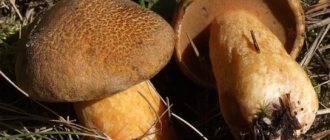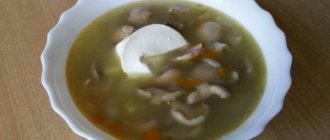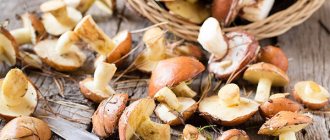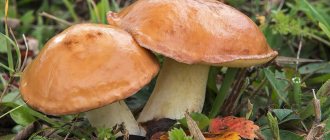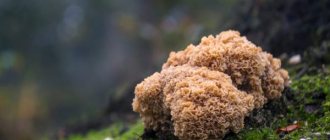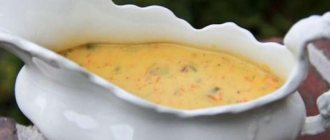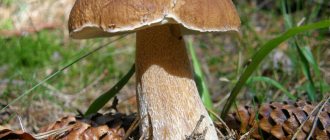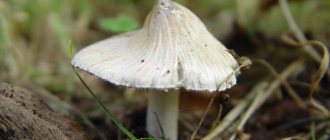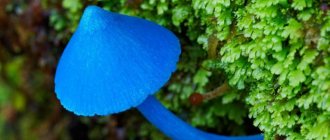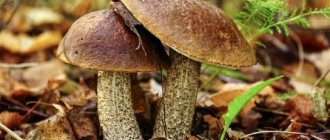The pepper mushroom or pepper mushroom is a tubular mushroom. It belongs to the Boletaceae family. Division Basidiomycetes. Class Agaricomycetes. Outwardly, it very much resembles the well-known, beloved and tasty butter dish, however, it contains negative properties that can have a bad effect on your body.
This mushroom got its name because of its unpleasant taste, which is very peppery, burns the tongue and even smelling this mushroom makes you want to sneeze. From Latin - Chalciporus piperatus .
Should mushroom pickers avoid pepper oilers? Where and when does it grow? How to distinguish it from a real edible butter dish? We will answer these questions in this article.
Pepper mushroom and goat. Pepper mushroom, Chalciporus piperatus
Cap: Color from copper-red to dark rusty, rounded-convex shape, 2-6 cm in diameter. The surface is dry, slightly velvety. The pulp is sulfur-yellow and turns red when cut. The taste is quite spicy and peppery. The smell is weak.
Hymenophore: Tubules descending along the stalk, cap-colored or darker, with uneven wide pores, quickly acquire a dirty brown color when touched.
Spore powder: Yellow-brown.
Leg: Length 4-8 cm, thickness 1-1.5 cm, cylindrical, solid, often curved, sometimes narrowed towards the bottom, the same color as the cap, yellowish in the lower part. There is no ring.
Distribution: Pepper mushroom is common in dry coniferous forests, found quite often, but usually not too abundantly, from July to the end of autumn. It can also, according to old data, form mycorrhiza with deciduous trees, for example, with young birches. However, on the serious website “Mushrooms of the Novosibirsk Region” it is indicated that in fact Chalciporus piperatus parasitizes. Looking at the speed with which the science of mycology is ahead of the human mind, it becomes somehow strange.
Similar species: Confused Chalciporus piperatus can be confused with various representatives of the genus (in other words, with boletus). The pepper mushroom differs from the boletus, firstly, in its radical taste, secondly, in the red color of the spore-bearing layer (in the boletus it is closer to yellow), thirdly, it never has a ring on the stem. They also write about a close relative of the pepper mushroom a mushroom called Chalciporus rubinus - it is associated with deciduous trees and is distinguished by its dark red pores. It is obviously much less common - or it is simply so similar to a more common species that it does not attract much attention from amateurs. At the same time, the contradiction between the obvious edibility and the described bitterness of the mushroom leads to suspicions that we are not very good at distinguishing between the pepper mushroom and Chalciporus rubinus, mainly dealing with the latter.
Edibility: The mushroom is certainly not poisonous. Many sources report that C. piperatus is "inedible due to its pungent peppery taste." A rather controversial statement - unlike, say, the disgusting taste of gall mushroom (), the taste of pepper mushroom can be called spicy, but pleasant. In addition, after prolonged cooking, the pungency disappears completely.
Author's notes: For a long time I collected and, accordingly, used pepper mushroom for its intended purpose, without particularly thinking about its edibility. Having learned that, according to our literature, this mushroom is “inedible due to its spicy peppery taste,” I decided, as they say, to put my fingers in the wounds - I picked this mushroom for a full-fledged roast, which was not so easy, since in my area it is found even often, but always a little - fried it and ate it for naturalistic purposes. We must admit that there is some grain of truth in the assessments of our culinary specialists. Yes, the mushroom is quite spicy, it’s not for everyone. (True, I am just a fan.) But you can eat. And as part of the “mushroom assortment” - it’s absolutely for the sweet soul. Thus, we have before us an exception (which, by the amazingness of its existence, emphasizes the rule): our sources consider the mushroom inedible, and most Western sources strictly contradict them. Usually it's the other way around. "Rare case."
Peppery or not peppery? There is a great temptation to declare this mushroom to be some special, perhaps even rare, representative of its genus. However, the large angular pores, the tubular layer sliding onto the stalk, and the general carelessness of the outlines leave no doubt: this is still the same pepper mushroom, although perhaps at the limit of its variability.
Here you can clearly see that the peppered mushroom is still not a goat mushroom, Suillus bovinus. Does a goat have such a developed hymenophore? The goat does not have such a developed hymenophore. And there is no such thing as a spicy pepper taste. It's strange to be confused.
As a rule, the pepper mushroom is distinguished not by its heroic appearance, but by its intricate curvature. Although their heads do not often grow together, it is evident that Chalciporus piperatus is solitary by nature.
Geography with cooking
Pepper mushroom is found almost throughout Russia and Europe from the Atlantic to the Pacific Ocean, not excluding the North Caucasus. There is also evidence that it was found on the island of Tasmania, located south of Australia. The mushroom “loves” pine forests with small herbs, less often – spruce forests, birch forests, mixed and deciduous forests, where it can be seen in dry, damp places, in clearings, near roads and forest paths. In some sources you can find mention that it parasitizes the fly agaric. It grows from July (in some places from the end of June) to October singly or in small groups of 2-3 pieces.
As for its edibility, this is a very interesting question, despite the seemingly unequivocal opinion of many authoritative sources. The fact is that pepper mushroom is often used to make one of the types of pepper. It is also known that in some cuisines of the world, the mushroom itself is used in small quantities as a spicy seasoning, after boiling it and preparing it accordingly. It is also believed (and there is evidence to support this) that dried pepper mushrooms can be used in powder form. Simply put, no one recommends eating pepper mushroom, but it is readily used as an additional ingredient. Although it must be said that many mushroom pickers also dispute this conclusion, arguing that when a mushroom is cooked in two or three waters, its taste weakens and gives the dish a slight piquant bitterness, which, according to them, allows it to be consumed in pickled, salted and even fresh forms . This opinion is also supported by the majority of Western scientists and ordinary mushroom lovers.
At the same time, in the same West, some mycologists, biologists and chemists, as well as official Russian-language mycology, declare that pepper mushroom is not just inedible, but poisonous, and that its effect on the body is cumulative and manifests itself only after some time. According to them, its pulp contains a rare toxin, which, during processing of the mushroom, instead of being neutralized, becomes a biological poison that can accumulate in the human body. This poison acts on liver cells, destroying their structure and causing mutation, which can lead to cirrhosis and liver cancer of unknown etiology. For those people who regularly consume pepper mushroom or its derivative in food, the first symptoms of poisoning appear after a few months in the form of stagnation of bile and other similar phenomena, which are felt as heaviness in the right hypochondrium. However, they do not associate these symptoms with eating the mushroom due to the fact that, as we have already mentioned, many perceive it as quite edible or, at worst, conditionally edible.
It is difficult to say who is right in these discussions, and after such a diversity of opinions, it is not at all surprising to come across queries on the Internet like “how to distinguish a pepper mushroom from such and such”
Perhaps we should once again draw the attention of amateur mushroom pickers, especially beginners, to caution, which never hurts when picking mushrooms. And if you decide to reproduce the experience of world cooking at home and prepare hot pepper from a pepper mushroom, we offer you a simple recipe:
- The collected mushrooms should be washed and broken well, then boiled and dried. If you use an oven for drying, dry it for at least three hours. In the first two hours, turn over twice, in the last hour turn over every 30 minutes until completely dry.
- chop the dried mushrooms and dry again for about the same time as the first time.
- pour into a jar for storage.
Cooks often use this powder along with regular ground black pepper, sprinkling a small amount of it on the finished dish.
However, it should still be used with caution: who knows how right the opponents of the pepper mushroom are...
Similar varieties
In nature, it has species similar in description.
- Kozlyak. Unlike the original, the twin is distinguished by the larger size of the fruiting body. It has an olive color of the pores of the tubular layer. The goat does not have a red tint, and the mushroom pulp does not have a spicy, peppery taste. Edible, however, collecting the required amount for cooking is difficult due to the extremely high worminess of both young and mature specimens.
- Gall (bitter). The structure of the pulp is more fibrous and has a white color. The tubular layer is creamy, later gray-pink. It has a less concentrated burning taste, which does not disappear with any heat treatment, but rather intensifies. If a large amount of toxins enters the body, it can cause cirrhosis of the liver. Inedible.
Definitioner
Basidia (Basidia)
Lat. Basidia. A specialized structure of sexual reproduction in fungi, unique to basidiomycetes. Basidia are terminal (end) elements of hyphae of various shapes and sizes, on which spores develop exogenously (outside).
Basidia vary in structure and method of attachment to hyphae.
Based on the position relative to the axis of the hyphae to which they are attached, three types of basidia are distinguished:
Apical basidia are formed from the terminal cell of the hypha and are located parallel to its axis.
Pleurobasidia are formed from lateral processes and are located perpendicular to the axis of the hypha, which continues to grow and can form new processes with basidia.
Subbasidia are formed from a lateral process turned perpendicular to the hyphal axis, which stops growing after the formation of one basidium.
Based on morphology:
Holobasidia are single-celled basidia, not divided by septa (see Fig. A, D).
Phragmobasidia are divided by transverse or vertical septa, usually into four cells (see Fig. B, C).
By type of development:
The heterobasidium consists of two parts - the hypobasidium and the epibasidium developing from it, with septations (see Fig. C, B) or without them (see Fig. D).
Homobasidia is not divided into hypo- and epibasidia and in all cases is considered to be holobasidium (Fig. A).
The basidium is the site of karyogamy, meiosis, and the formation of basidiospores. Homobasidy, as a rule, is not functionally divided, and meiosis follows karyogamy. However, the basidia can be divided into probasidium, the site of karyogamy, and metabasidium, the site of meiosis. Probasidium is often a resting spore, for example in rust fungi. In such cases, the probasidium germinates into a metabasidium, in which meiosis occurs and on which basidiospores are formed (see Fig. E).
See Karyogamy, Meiosis, Hypha.
PileipellisLat. Pileipellis, skin - a differentiated surface layer of the cap of agaricoid basidiomycetes. The structure of the skin in most cases differs from the inner flesh of the cap and may have a different structure. The structural features of pileipellis are often used as diagnostic characters in descriptions of fungal species.
Based on their structure, they are divided into four main types: cutis, trichoderma, hymeniderma and epithelium.
See Agaricoid fungi, Basidiomycete, Cutis, Trichoderma, Hymeniderma, Epithelium.
Butter - what can be prepared from them
I offer you several recipes for boletus dishes that I have tested. If you find butter, be sure to try cooking something according to my recipes. I think you'll like it.
Marinated boletus
Marinated boletus is a wonderful appetizer on the holiday table, and on weekdays it is a great addition to boiled potatoes.
We thoroughly rinse the sorted and cleaned boletus under running water several times. Don’t forget that dangerous bacteria, pathogens, can be brought in with the soil. Place the mushrooms in a saucepan and add a little water. During the cooking process, the mushrooms themselves will still release their liquid. Add salt to taste. Cook the mushrooms over medium heat for 30 minutes. During the cooking process, skim off the foam until the mushroom broth becomes transparent.
Since I pickle mushrooms for the winter, during the process of cooking the mushrooms I simultaneously prepare glass jars: I wash them thoroughly with soap and rinse. Then I sterilize them over the kettle. Of course, you can sterilize jars in the microwave or oven. But who is used to it. At the same time, I boil metal lids and a spoon in a separate bowl, which I will use to remove the lids from the bowl (maintain sterility!)
Popular articles Preparation of fir oil
Then we proceed directly to the marinating process. There are 2 options for marinating. You can drain the broth from boiled mushrooms, and then add a separately cooked marinade to it.
I'm doing it differently. The mushroom broth is very tasty, I’m sorry to throw it away. That’s why I add all the spices for the marinade directly to the mushroom broth.
Marinade for mushrooms: to 1 liter of water or mushroom broth I add 5 pieces of black pepper, 5 pieces of allspice, 5 cloves, 2 bay leaves and half a teaspoon of ground cinnamon.
Shortly before the end of cooking, add 1 tablespoon of vinegar essence and boil for another 5 minutes. Place hot mushrooms in sterile jars. Sterilize half-liter jars for 10 minutes, 700 gram jars for 15 minutes. Roll up, turn the lids down and leave until completely cool.
Roast butter
Product set:
- Boletus mushrooms, washed in water (or you can use any other mushrooms) – 1 kg
- Butter or ghee - 3 tbsp.
- Sour cream -100 grams
- Onion-turnip -2 -3 pcs.
Place thoroughly cleaned and washed boletus in a deep frying pan, add salt to taste, simmer over medium heat, stirring occasionally so that it does not burn. Remove the foam that appears from the mushrooms. As soon as the foam begins to appear, first add the butter and onion, and then the sour cream. Stirring occasionally, bring to readiness.
Sometimes there are not many mushrooms, in which case you can add chopped mushrooms. This makes it even tastier.
Or alternating fir-tree and birch plantings - it doesn’t matter to the oiler. If there are needles under your feet, then this place is perfect for an oil can.
The oil can grows
friendly families, throughout the summer and into the warm autumn. It has very nice appearance: a shiny brown cap, a strong elastic leg, and a bright yellow bottom of the cap, like a soft, pleasant sponge.
Oiler
It is considered one of the most delicious mushrooms; it is excellent for pickling for the winter and for preparing various dishes; it does not require long-term heat treatment.
But Oil Can also has one significant drawback: special mucus.
, which, covering young mushrooms, makes them slippery and shiny - it is thanks to it that this mushroom got its name - Butter Dish, as if lubricated with oil it strives to jump out of your hands and shimmers appetizingly in the sun.
Also, because of this mucus, experienced mushroom pickers prefer to collect boletus while wearing fabric gloves.
, which protect the skin from oily mucus, the mucus is of course completely harmless, but in the open air it oxidizes, turning your hands a dark brown color, which is not washed off with detergents, but only disappears on its own after a few days.
Can it be eaten?
Unfortunately, there is no clear answer to this question. Different sources contain conflicting information on this matter, classifying the mushroom as conditionally edible, inedible and even poisonous.
Check out the lists of common edible, conditionally edible and poisonous mushrooms.
If you believe numerous mushroom picker encyclopedias, pepper buttercup does not contain poison. It is classified as conditionally edible due to its bitter taste. However, there are sources that claim that its taste is not spicy, but pleasant, and the bitterness goes away after heat treatment. Therefore, this butter dish is recommended to be used as a hot seasoning, replacing pepper. To add spiciness to the dish, pepper mushrooms are boiled and added as is, or dried and ground into powder. According to reviews of people who have prepared pepper mushroom, it is tasty dried and fried. It is also pickled and salted.
In some Western and Russian sources devoted to mushroom families, Chalcíporus piperátus is classified as inedible and poisonous. There is an opinion that its pulp contains toxic substances that are not removed by heat treatment and tend to accumulate in the human body. They provoke liver destruction and can lead to cirrhosis and cancer. Symptoms of poisoning, as a rule, do not appear immediately after eating the mushroom, but only after several months. Therefore, it is difficult to prove exactly that a mushroom dish is the cause of a person’s poor health.
Let us note that most authors of literature on the mushroom topic still tend to consider the pepper butter dish to be conditionally edible. It does not lead to rapid poisoning or death.
Did you know? Mushrooms contain more minerals such as iron, phosphorus and calcium than any meat. They also contain 5 to 10 times more niacin (vitamin B3) than greens and vegetables.
How to get rid of pigeons on a balcony roof: repelling methods
Pigeon Repel WireOne of the options is a bird trap. Anyone can do it at home. To do this, we construct a loop from a thick thread, pour grains into the center and place them at low tide. When the dove lands in the center, you should tighten the thread with a sharp movement of your hand.
More cruel methods include pulling a fishing line or sharp wire across the width of the visor, which will injure the birds’ legs. Nails driven upside down will cause pain and will forever scare away pigeons from the windowsill.
Pigeons are very smart birds, so if there is some food or water on the balcony, they will become frequent guests of this room. Therefore, it is necessary to remove any means of food from the unglazed balcony, then the birds will stop flying in, since there will be no point in this.
It is also worth noting that turtle doves often look for balconies to build their nests. How to scare away pigeons from the balcony in this case? Firstly, use the above recommendations
And secondly, remove all furniture and objects on which a nest could be built. However, it is not always possible to monitor the laying of eggs, and the owners no longer find an empty nest, but with testicles.
We suggest you read: Rubber sole squeaks when walking, what to do
Pepper mushroom: poisonous or not
Pepper mushroom is an eternal subject of debate among mushroom pickers and doctors. Some believe that the mushroom is poisonous and eating it is strictly prohibited. Opponents claim that it is completely safe and can serve as an addition or even the basis for a delicious lunch. Let's try to consider all versions.
Pepper Mushroom (Pepper Mushroom, Pepper Butter): The Perfect Mushroom Seasoning
The pepper mushroom or pepper mushroom is a tubular mushroom. It belongs to the Boletaceae family. Division Basidiomycetes. Class Agaricomycetes. Outwardly, it very much resembles the well-known, beloved and tasty butter dish, however, it contains negative properties that can have a bad effect on your body.
This mushroom got its name because of its unpleasant taste, which is very peppery, burns the tongue and even smelling this mushroom makes you want to sneeze. From Latin - Chalciporus piperatus.
Should mushroom pickers avoid pepper oilers? Where and when does it grow? How to distinguish it from a real edible butter dish? We will answer these questions in this article.
hat
The first thing a mushroom picker in the forest pays attention to is the diameter of the cap. In the pepper representative it ranges from 3 to 7 cm
Popular articles Peony (Paeonia tenuifolia) - planting and care in open ground
By the way, the shape of the cap is always round and convex, and even by the end of the season its tips do not rise up.
Depending on the composition of the soil, as well as the abundance of sunlight, the cap may have a very rusty or even reddish tint.
If you try the surface of the mushroom with your hand, it will seem a little velvety and rough, but dry and not at all moist.
Leg
If you look at the length of the leg, it will be approximately 8 cm. And its width varies from 1 to 2 cm. Look at the shape of the leg. It is cylindrical in nature, and very often has a visible curvature.
Sometimes it narrows downwards on purpose. The stem can be described as solid, and in its color it repeats the shade of the cap, however, the closer we go down to the roots, the more yellow the color appears on the trunk.
The pepper representative does not have a peculiar ring on the stem.
When the growing season of these mushrooms comes to an end, the stem becomes hollow and can barely support the weight of the cap.
Pulp
If you still doubt whether the mushroom in front of you is poisonous or non-poisonous, the flesh of the cap will help you answer this difficult question.
If you taste the pulp on the tip of your tongue, you will feel how peppery the taste is, even a little spicy. This is where the name of this forest dweller came from. You can also smell the pulp.
It has a mild mushroom character.
https://youtube.com/watch?v=-yFLIqyP_p8
If you look under the cap, you will see tightly formed tubes of a dark shade adjacent to each other.
They contain uneven pores that have a dirty brown-brown tint. It is from these holes that spore powder will fall out, which by the next season will increase the number of mushrooms by one square meter.
The hat is very loose on the back side, a finger can easily fit into it.
Habitat
Where is the risk of meeting these representatives of the forest kingdom?
It is worth noting that such pepper mushrooms choose only dry coniferous forests for their growth and development. They do not accept deciduous or mixed forests.
By the way, you can come across these mushrooms quite often along the way.
However, their growth is not very abundant, for example, they do not like to be in large numbers on one square meter; the mycelium usually produces three or four mushrooms per season.
Pepper butterbugs most often form mycorrhizae with various deciduous trees, but only in rare cases. Most often they prefer birch or spruce.
Therefore, pepper butterfish choose for their place of growth and development more shady, even humid areas, which are located along the banks of swamps, lakes and rivers.
Neutral Milkweed (Lactarius quietus)
HABITAT: mixed, deciduous and oak forests, growing singly and in groups.
SEASON: July - October.
The cap has a diameter of 3-7 cm, sometimes up to 10 cm, at first it is convex, later spread out, and becomes depressed in old age. A distinctive feature of the species is its dry, silky, mauve or pinkish-brown cap with noticeable concentric zones.
The stem is 3-8 cm high, 7-15 mm thick, cylindrical, dense, then hollow, cream-colored.
The flesh of the cap is yellowish or light brown, brittle, and the milky juice does not change color in the light.
The plates are adherent and descending to the stem, frequent, cream or light brown, later acquiring a pinkish tint.
Variability: The color of the cap can vary from pinkish brown to reddish brown and creamy purple.
Similarities with other species. The neutral milkweed in shape and the presence of concentric zones of pinkish-brown color is similar to the good edible oak milkweed (Lactams zonarius), which is much larger and has fluffy, rolled-down edges.
Methods of preparation: salting or pickling after pre-treatment.
Edible, category 4.
Useful properties, medical use and restrictions on use
According to a number of studies, the mushroom contains a toxic substance that is not neutralized by heat treatment and is not removed from the body. It can cause cirrhosis and liver cancer.
Nevertheless, this species is used in folk medicine. The mushroom contains substances such as leucine and alanine, which help lower blood sugar levels and normalize weight. It is also rich in phytoncide, which is a natural antibiotic. The fruits contain protein, phosphorus, magnesium, selenium, and folic acid.
Pepper mushroom
Due to its chemical composition, pepper moss is used in medicine to make drugs that help cope with the following conditions:
pressure stabilization; improving the functioning of the immune system; destruction of cholesterol; strengthening the nervous system; activation of brain activity.
Cooking full-fledged dishes from pepper butter is not practiced, but it is often used as an additive to other types or as a spicy note in the preparation of other products. Restrictions on the consumption of such food apply to children, pregnant women and people with chronic diseases.
Application
In traditional medicine
Surprisingly, this mushroom is used not only in folk, but also in traditional medicine. The healing properties of this mushroom are highly valued, as well as its special composition, which contains substances beneficial to the human body.
Various preparations are made based on pepper oil. Basically, they are aimed at the following effect on the body.
- Positively affects the immune system.
- May have an effect on reducing cholesterol plaques.
- Helps launch brain activity.
- Positively affects blood pressure.
- Helps cleanse the liver.
- Can significantly strengthen the nervous system.
- Metabolism increases several times.
As a result of the fact that the mushroom contains a record amount of vitamins, it was found that it is very useful for metabolism. Also, this mushroom is recommended for those who want to lose weight.
In addition, pepper mushroom is a natural antibiotic due to the fact that it contains a huge amount of phytoncides.
Pepper oil is not used in its pure form, but as a carefully processed component that can fight various types of infections, both viral and bacterial.
By the way, it is worth noting that you should not self-medicate if you develop one of the listed diseases and eat such mushrooms in large quantities. Unfortunately, other than poisoning or an upset stomach, you will not earn anything for yourself.
In folk medicine
Surprisingly, pepper mushroom is also widely used in folk medicine. True, not in its pure form. An extract is made from it, which is then subsequently processed into an ointment. It can be used against various skin imperfections, including papillomas and warts.
You can make a tincture from the mushroom. It helps to properly influence the economy of conjunctivitis.
If you have any eye diseases that involve swelling, then you will need peppercorn powder, which is soaked in an herbal solution. Thanks to its use, rapid tissue scarring can be expected.
Also, this mushroom is effective for the treatment of pyelonephritis and urolithiasis, and promotes the rapid removal of stones from the body.
Interesting Facts
A number of mycologists are inclined to believe that pepper oil contains a rare toxin in its chemical composition, which is not destroyed during heat treatment, accumulates over a long time in the human body and leads to the development of oncology and cirrhosis of the liver. There is no definitive scientific evidence for this yet.
- https://gribowiki.ru/condit/perechnyj-grib.html
- https://wikigrib.ru/perechnyj-grib/
- https://mirgribnika.ru/nesedobnye/perechnyj-grib.html
- https://gribnikoff.ru/vidy-gribov/ne-sedobnye/perechnyj-grib/
- https://pro100ogorod.ru/uslovno-sedobnye/perechnyj.html
Characteristic features of the variety
People have several names for this species, for example oiler or pepper fly. It got its name for its specific bitter taste.
Appearance and photo
The specimen in question belongs to the tubular mushrooms; it is brown in color. It has a convex cap and a cylindrical stem of small diameter. The pulp of the fruiting body is loose and brittle, yellow in color.
There is no pungent odor, but there is a bitter taste, and the flesh changes color when cut or pressed. The stem matches the color of the cap and does not have a ring, which will help in identifying this forest dweller.
Structure and species differences
Pepper oiler belongs to the Boletaceae family, class Anaricomycetes. The species has the following structural features:
- The mushroom cap is convex in shape and becomes flatter as it grows. Diameter - up to 8 cm. The color range ranges from light brown to copper, and can also acquire red and brown shades depending on the habitat. The surface is dry and velvety to the touch, but becomes slimy in rainy weather.
- The height of the leg reaches 4-8 cm, in diameter - 1.5 cm. The leg is cylindrical in shape, narrowed downward, often curved, smooth texture. The color is the same as that of the cap, but maybe a little lighter; at the bottom it has a yellow tint. There are no rings.
- The pulp is loose in structure and breaks easily, changing color to red when cut. The taste of the pulp is like hot pepper, but there is no distinct specific smell.
- The tubular layer is adherent, the same shade as the mushroom cap, pores of irregular angular shape. When pressed, it acquires a dirty brown tint.
Pepper oiler
This structure of the pepper mushroom makes it possible to distinguish it from other fellows in the forest by external signs.
Advice from experienced mushroom pickers
Experienced mushroom pickers recommend:
- You should not collect mushrooms that have a tuberous thickening that is covered with a torn shell;
- it is impossible to collect overgrown or old, as well as wormy fruiting bodies in which toxic substances and elements of protein decomposition have accumulated;
- It is best to pick mushrooms in drizzling rain or cloudy weather;
- People suffering from diseases of the liver, kidneys, and gastrointestinal tract should not eat mushroom dishes;
- It is not recommended to use dishes using mushrooms in the menu of children under twelve years of age;
- all collected mushroom fruiting bodies must be processed as quickly as possible;
- pre-treatment of mushrooms includes trimming the root part of the fruiting body, removing large adhering forest debris, as well as thorough rinsing in running water;
- mushrooms belonging to the lacticiferous species must be soaked in water for several days, replacing the water several times a day, which will remove bitter or caustic, abundant milky juice from the fruiting bodies;
- it is optimal to pre-boil the mushrooms, which allows you to remove a significant part of all harmful components from the fruiting bodies;
- inexperienced, novice mushroom pickers can be recommended to collect tubular rather than lamellar mushrooms.
Edibility
Regarding the edibility of pepper butter, Russian and foreign scientists and practitioners show surprising “unfriendliness”.
There are three main opinions that are equally zealously defended by their own group:
- The mushroom is inedible. Official opinion of Russian-language science. Biochemists said that these oils contain rare and very toxic compounds that are not destroyed by heat treatment. They slowly but consistently destroy the liver, leading to cirrhosis and cancer.
- The butter dish is edible. The official opinion of English-speaking science. Some mushroom pickers from Europe openly call its taste “amazing.”
- The mushroom is conditionally edible. Opinion of Russian mushroom pickers. “Experimentally” they found out that when the pepper mushroom is cooked in two or three waters, its bitter taste is significantly weakened and gives the dish a pleasant piquancy. Some people believe that such a butter dish is suitable for food not only as a seasoning, but also in pickled, salted and even fresh form. But other mushroom pickers hold the diametrically opposite opinion and do not recognize pepper butter in any form.
One thing can be said for sure - this mushroom is not absolutely poisonous, causing severe poisoning and quick death.
Growing baby goat mushrooms
Baby goat mushrooms can be grown at home, in the garden. However, if you have space, you can grow it in an apartment.
Popular articles Description and characteristics of Pendula larch
Of course, the method is suitable only for those who really love this type of mushroom.
To grow it, you need to prepare a container for it. Small boxes will do. They are needed for the first stage of growing mycelium. The boxes are filled with fertile soil. Then small holes are made, into which pieces of mycelium are placed. The planting time can be any, but it is still recommended that the mycelium be planted between September and early May. Having placed the mycelium in the holes, it is covered with soil. As the soil dries, it becomes moist.
Over the winter, the mycelium in the box will grow and by spring it will be ready for planting in the garden plot.
It is advisable to find a site near a coniferous tree. But, if there is none, it is enough to plant it where the soil is the wettest. Holes with a diameter of 10 cm and a depth of 20 cm are first dug. The earth is first mixed with wet sawdust, and only then the holes are dug there.
Then the mycelium of the fungus is placed in the holes. After this, you need to pour a liter of water with lime diluted in it into each hole. Lime is diluted at the rate of 50 g of lime per bucket of water. As a result, we will thus disinfect the soil.
Then the area with the planted mycelium must be covered with branches, moss or leaves. On particularly hot days, you will need to pour 2 to 3 buckets of water onto each hole.
Otherwise, no care or maintenance is required. However, it seems to me that if you have mushroom spots, it’s better to go into the forest and pick there. It will be both useful and pleasant.
A year after planting, mushrooms will appear. In the first year, the harvest will not be so large and plentiful. The mycelium develops for about 5 years. In subsequent years the harvest will be good. The lifespan of mycelium is about 15 years.
Seasoning recipe
So, you've picked a whole basket of pepper mushrooms. What can be made from them?
- So, first of all, you need to clean the mushrooms. To do this, they are washed well under running water, and all imperfections are also removed. It is also advisable to remove the top part of the skin.
- The next step is to cut this mushroom into small pieces, after drying them well with a towel.
- Place paper on a baking sheet and you can leave the mushrooms to dry in the oven at 40 degrees. At the same time, the oven door should be slightly open.
- Depending on the number of mushrooms, as well as the size, the drying process can take from 2 to 6 hours.
- Then, if there is bright sun shining outside your window, place the baking sheet with dried mushrooms in direct sunlight.
- As soon as the mushrooms begin to break under your touch, the seasoning can be considered ready.
It can be made in two ways. If you have a good coffee grinder, quickly grind some powder for yourself.
If you don’t have a coffee grinder, you can wrap the mushrooms in cheesecloth and crush them properly with a hammer. Once you feel that all the large pieces have been crushed, you can pour the seasoning into a specially prepared container.
Pepper mushroom in powder form will be a great find for your culinary explorations. All that remains is to properly prepare this aromatic mixture.
Distribution and collection time
In nature, silverback can be found in Europe and Asia, in forests dominated by birch and aspen, as well as in mixed plantings. This mushroom prefers to grow in northern areas. It can often be found in Siberia.
Serushki grow singly or in large groups, mainly in moist sandy or loamy soils. They are common on forest edges, along the sides of paths and roads. If you are interested in how long the putik harvesting season lasts, then their fruiting begins in July and ends in September.
